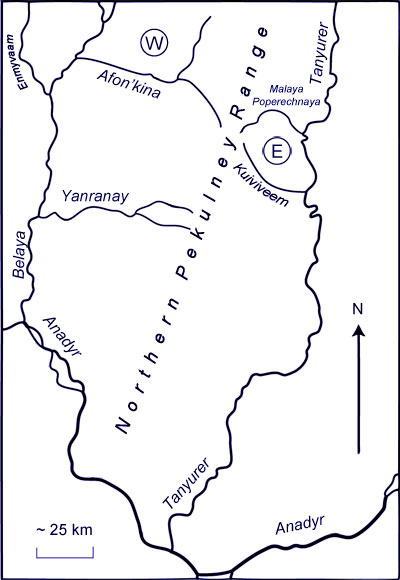Pekul'nei Ridge
| Introduction | Pekul'nei East | Pekul'nei West | NE Russia Map | Pekul'nei East Fossil Images | Pekul'nei West Fossil Images |
|---|
One of the richest and most diverse floras from the Upper Cretaceous lies in plant-bearing continental deposits at the northern end of the Pekulney mountain range within the AKSR subregion of Northeastern Russia. Until recently the flora was known collectively as the Tylpegyrgynai Flora (Terekhova and Filippova, 1983, 1984). The plant-bearing deposits were discovered in 1956 by geologists working for the USSR Geological Survey and although a collection of plant fossils was examined by Yefimova it was never formally published, Yefimova’s observations existing only as an internal report of the Northeastern Geological Survey, Magadan. A more detailed work was published by Terekhova and Filippova (1983, 1984), who examined the stratigraphy of the western and eastern slopes of the northern Pekulney Range, including the non-marine plant-bearing beds and the bounding marine units. Both the Tylpegyrgynai Formation on the western slopes and the Poperechnaya Formation on the eastern slopes yield plant fossils. The Poperechnaya Formation is dated as Early Coniacian on the basis of biostratigraphic constraints of overlying and underlying beds containing marine molluscs. For the Tylpegyrgynai Formation, the upper age limit is constrained as Early Coniacian based on marine fossils in an overlying deposit, but the lower age limit remains uncertain because of an erosional basal contact with underlying sediments of Valanginian age. Large numbers of plant fossil specimens have been collected from both formations and have been described by Filippova (1991, 1994); Filippova and Abramova (1993). The fossil floras from the Tylpegyrgynai and Poperechnaya formations were regarded as being of similar taxonomic compositions and were therefore likely to reflect a single floral association. This association was named the Tylpegyrgynai Flora by Filippova (Terekhova and Filippova, 1983, 1984). With the kind support of Filippova, Herman and Spicer photographed the Tylpegyrgynai Flora collections in Magadan in 1994. Subsequently Craggs (2005) used this photographic record to determine the paleoclimate of the Tylpegyrgynai Flora and concluded that because of climatic and compositional differences the floras from the Poperechnaya and Tylpegyrgynai formations should be regarded as distinct entities: The Poperechnaya Flora and the Tylpegyrgynai Flora. She referred to the combined floras as the Northern Pekulney Range Flora. Taken together the floras are dominated by angiosperms followed by conifers, ferns, cycadophytes, ginkgophytes and sphenophytes, in decreasing order of species diversity. |
Interactive map showing positions of the Eastern and Western Pekul'nei Ridge taphofloras.
Correlation chart showing the relationships between the marine biostratography and plant-bearing formations in the Pekul'nei Ridge area. Non-marine beds are in gray. Modified from Terekhova and Filippova (1983, 1984). |


